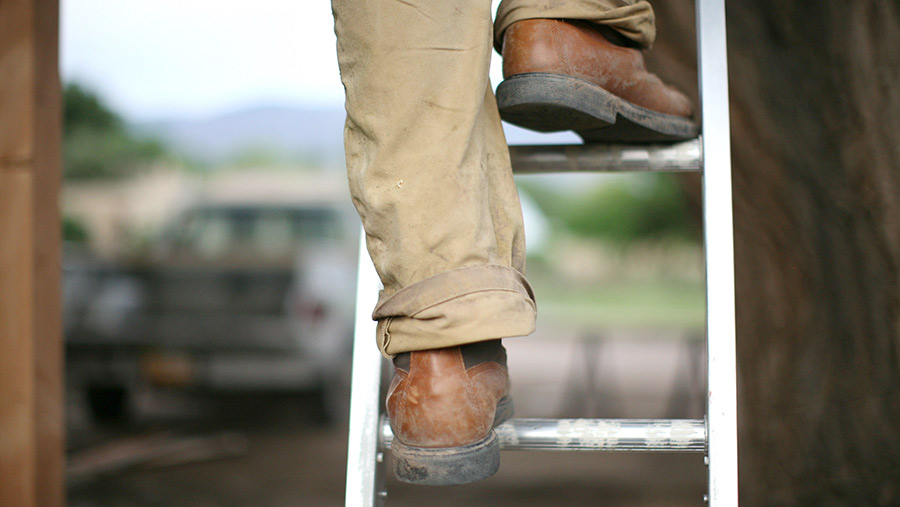Safety campaign aims to reduce falls from height
 © Mary Hobbs/Alamy Stock Photo
© Mary Hobbs/Alamy Stock Photo Preventing injuries and fatalities involving falls from height on farms is the goal of a national safety campaign this autumn.
After accidents involving vehicles (36%), falls from height (18%) are the second biggest cause of farming fatalities.
The campaign is being co-ordinated by the Farm Safety Partnership, which brings together more than 35 farming organisations – including Farmers Weekly.
See also: Major campaign to reduce farm fatalities in 2019 – and beyond
It is part of a year-long seasonal initiative focusing on different aspects of farm safety.
Preventing falls from height is the focus this autumn.
The campaign has already looked at farm transport (winter), working safely with livestock (spring) and child safety (summer).
Falls from height accounted for seven of the 39 fatalities on British farms during 2018-19, according to Health and Safety Executive statistics.
Incidents involved a fall from a ladder, a fragile roof, a platform or lifting equipment and a combine harvester.
Agriculture has the worst rate of worker fatal injury of the main industrial sectors.
Farmworkers are 18 times more likely to be killed at work than than all-industry average rate, with older workers particularly at risk.
And nearly half those killed are over 60.
Fatal injuries
In one incident, a 66-year-old self-employed farm partner was killed when he fell from a ladder while working at height in a redundant grain store.
He was found on the ground with the ladder beside him but died of head injuries.
In another incident, a 50-year-old self-employed farmer was killed when he fell through a fragile roof.
He was clearing the valley gutter of the building and fell through a skylight on to the concrete floor. He too died of head injuries.
Key points
- Avoid roof work or work at height maintaining buildings. Do as much as you can from the ground.
- Use a professional contractor with the knowledge, skills equipment and experience to safely work at height on buildings. Avoid doing the work yourself.
- Where maintenance work at height cannot be avoided, plan ahead to make sure you have the right equipment and training.
- Don’t be tempted to use the wrong equipment.
A 20-year-old farm worker was killed when he fell from a barn roof.
He was attempting to lift roof sheets from a telehandler when he fell.
And an 88-year-old self-employed farmer died of his injuries in hospital after falling from a combine harvester while cleaning it.
Falls also frequently involve often involve bale stacks, and unsuitable access equipment, such as buckets.
Those who survive suffer broken bones and worse.
As well as pain, these accidents and injuries cost farm businesses time and money – yet most can be avoided (see box below).
How to minimise accident risk on the farm
Farmers and farm managers should ensure all work involving working at height is properly planned, says the Health and Safety Executive (HSE).
It should be supervised and carried out by competent people with the skills, knowledge and experience to do the job.
A sensible approach should be taken when considering precautions.
Low-risk, straightforward tasks will require less effort when planning – and there may be some situations where no particular precautions are necessary.
But the right type of equipment must always be used.
The law says farmers must:
- avoid work at height where at all possible
- prevent falls by using the right equipment or other measures
- minimise the distance and consequences of a fall
Risks should be carefully assessed, says the HSE.
Factors to weigh up include the height of the task – whether working at height can be avoided, the duration and frequency, and the condition of the surface being worked on.
For each step, farmers should consider measures that protect everyone – such guardrails, scissor lifts or tower scaffolds – before measures that require the individual to act for it to be effective, such as a safety harness that must be correctly worn and securely attached.
In all cases, as much work as possible must be done from the ground.
Workers must be able to get safely to and from where they work at height.
All equipment must be suitable for the job and it must be maintained and checked regularly.
Jack of all trades
Farm Safety Partnership chairman and NFU vice-president Stuart Roberts said: “During the last few months of the year many farmers look to do general maintenance around the farm.
“While we farmers like to consider ourselves a jack of all trades, we need to start asking ourselves, what if the shoe was on the other foot? Would we let a builder grow our crops or care for our livestock?
“Even if we’ve always done something a certain way, we need to take the time to consider the safest course of action.
“Whether it’s finding a way to do the job from the ground, investing in training staff or hiring a professional contractor, all it takes is a bit of planning to make sure we have the right people, the right training and the right equipment for the job at hand.
“A safe workplace is not only crucial for our welfare and the welfare of our employees, but for the sustainability of our businesses too.”
Ladders not banned – but use them safely
There is a common misconception that ladders and stepladders are banned, but this is not the case.
There are many situations where a ladder is the most suitable equipment for working at height, says the Health and Safety Executive.
But people using ladders must be competent, it warns.
Ladders should not be used if there is a safer way of doing the job – such as using a scaffold or suitable working platform.
Damaged or ‘home-made’ ladders – should be taken out of use and destroyed or properly repaired.
If the job is simple and quick – taking minutes rather than hours – then the HSE says a good ladder can be used.
But it must have has level and firm footing, must be secured to prevent it slipping and must not be leant against a fragile surface, such as fibre cement or plastic gutters.
Using a person to foot a ladder is not very effective and should only be a last resort.
When working from a ladder, try to maintain three points of contact with it at all times – such as both feet and one hand.
Aim to keep both hands on the ladder as much as possible.
Norfolk farmer lucky to be alive after fall

Tim Papworth and the part of his skull that had to be removed
Grower Tim Papworth had part of his skull removed in a life-saving operation after falling 14ft off a ladder in his potato store while changing a lightbulb.
Mr Papworth underwent a series of operations to relieve the pressure on his brain following the accident at Tunstead, near North Walsham, Norfolk.
He spent five weeks in a drug-induced coma after being airlifted to Addenbrooke’s hospital in Cambridge.
“Changing a lightbulb is an everyday occurrence,” he says.
“But that is what I was doing and I fell on to concrete.
“I put my arm out – I didn’t break it but I knocked my head very badly. I had two bleeds on the brain and I was paralysed on the left side of my body.”
The long road to recovery included speech therapy, occupational therapy and physiotherapy, adds Mr Papworth.
“I had every kind of therapy going – the only thing I haven’t recovered is my hearing. I am deaf in one ear.”
Now back farming, he has a titanium plate in his skull.
And he acknowledges he should have been more careful.
“There’s no reason for me to do what I did – but like many farmers, I took a risk” he admits.
“Ladders are dangerous equipment.”
